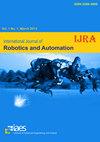行走相平面分析及其在两足动物和假肢控制中的应用
IF 1
4区 计算机科学
Q4 AUTOMATION & CONTROL SYSTEMS
International Journal of Robotics & Automation
Pub Date : 2020-02-28
DOI:10.15406/IRATJ.2020.06.00201
引用次数: 1
摘要
在人机集成实验室,我们一直在设计可穿戴机器人。对于我们的机器人系统,必须确定用户的行走模式和意图,以产生适当的电机输出。在过去,我们已经使用了可调的步态模式,可变的刚度模式,以及一个基于胫骨的控制器。在本文中,我们主要通过研究相位曲线来理解人类的步态及其潜在模式。例如,我们使用柄相位角的进展作为节拍器来确定用户的步态周期百分比。我们进一步研究了小腿的相位角作为脚相位角的函数。给出了两个相角之间的信号模式。这种模式似乎对不同的任务是不变的,比如步行、快速行走和在斜坡上行走。在未来,希望可以使用具有独特方向和角速度的柄相角来确定独特的脚相角,从而产生适当的电机输出。本文章由计算机程序翻译,如有差异,请以英文原文为准。
Phase plane analysis of walking with applications in controlling bipeds and prostheses
In the Human Machine Integration laboratory, we have been designing wearable robots. For our robotic systems, the user’s walking pattern and intent must be determined to generate appropriate motor outputs. In the past, we have used tunable gait patterns, variable stiffness patterns, and a tibia based controller. In this paper, we focus on understanding human gait and the underlying patterns by studying phase curves. For example, we use the progression of the shank phase angle as a metronome to determine the user’s percent gait cycle. We go one step further by studying the phase angle of the shank as a function of the phase angle of the foot. A signature pattern between the two phase angles is shown. The pattern seems to be invariant to different tasks such as walking, walking quickly, and walking on slopes. In the future, it is hoped that a shank phase angle with a unique orientation and angular speed can be used to determine a unique foot phase angle allowing the generation of appropriate motor outputs.
求助全文
通过发布文献求助,成功后即可免费获取论文全文。
去求助
来源期刊
CiteScore
1.20
自引率
44.40%
发文量
71
审稿时长
8 months
期刊介绍:
First published in 1986, the International Journal of Robotics and Automation was one of the inaugural publications in the field of robotics. This journal covers contemporary developments in theory, design, and applications focused on all areas of robotics and automation systems, including new methods of machine learning, pattern recognition, biologically inspired evolutionary algorithms, fuzzy and neural networks in robotics and automation systems, computer vision, autonomous robots, human-robot interaction, microrobotics, medical robotics, mobile robots, biomechantronic systems, autonomous design of robotic systems, sensors, communication, and signal processing.

 求助内容:
求助内容: 应助结果提醒方式:
应助结果提醒方式:


